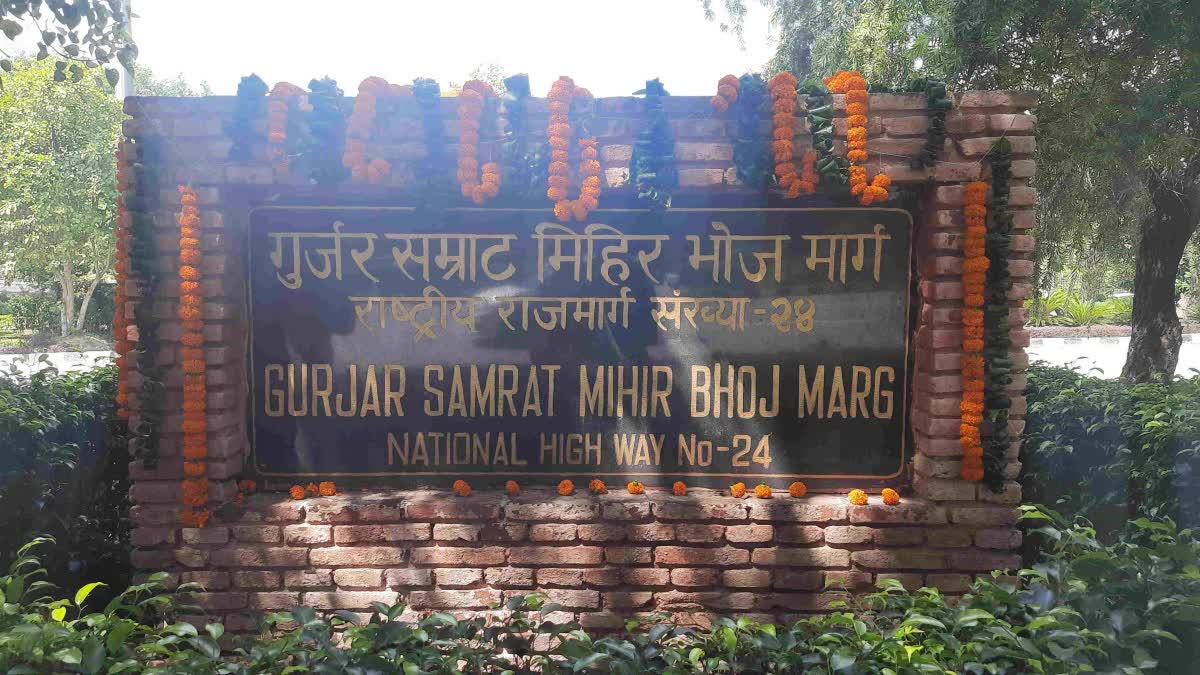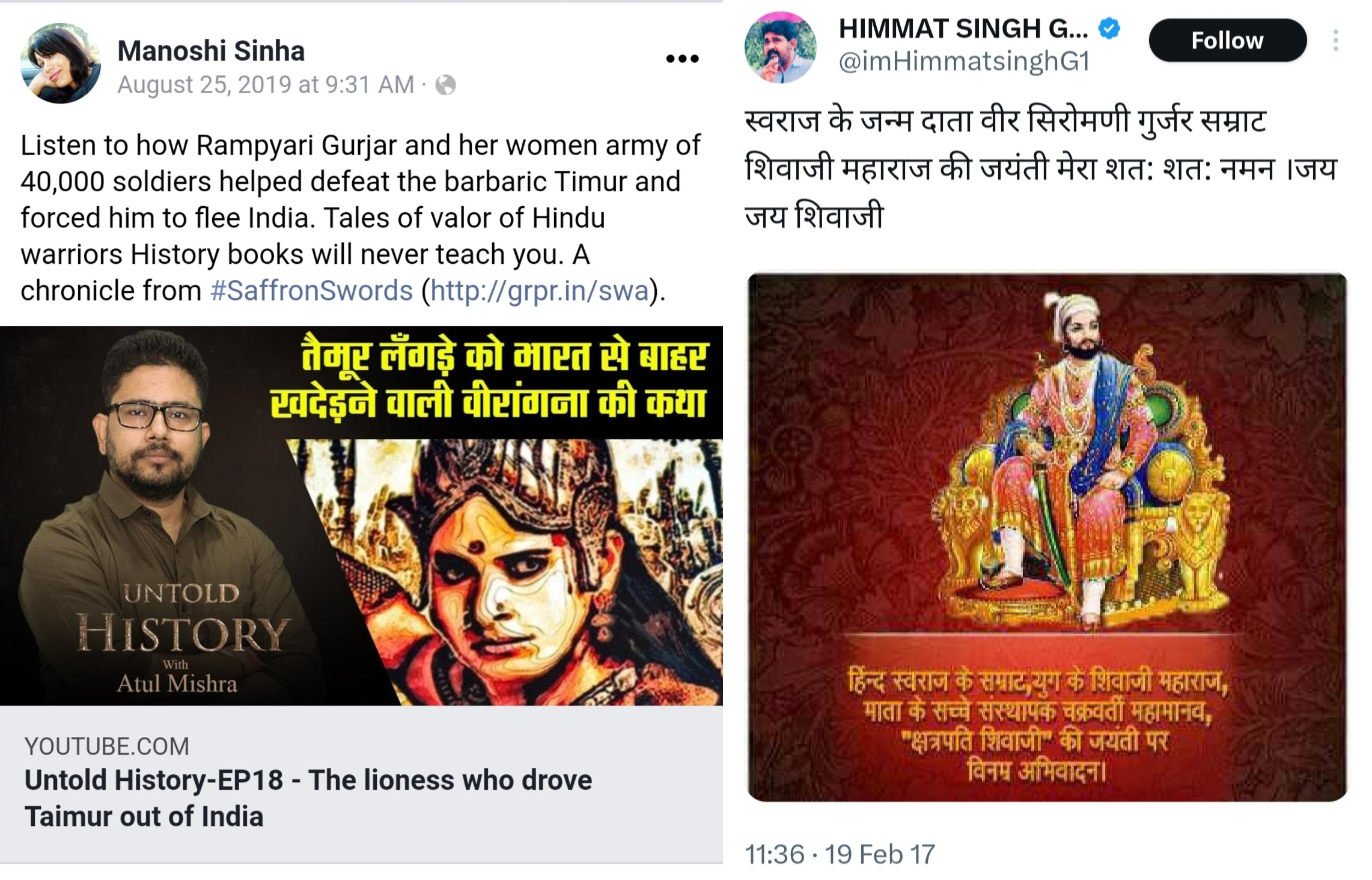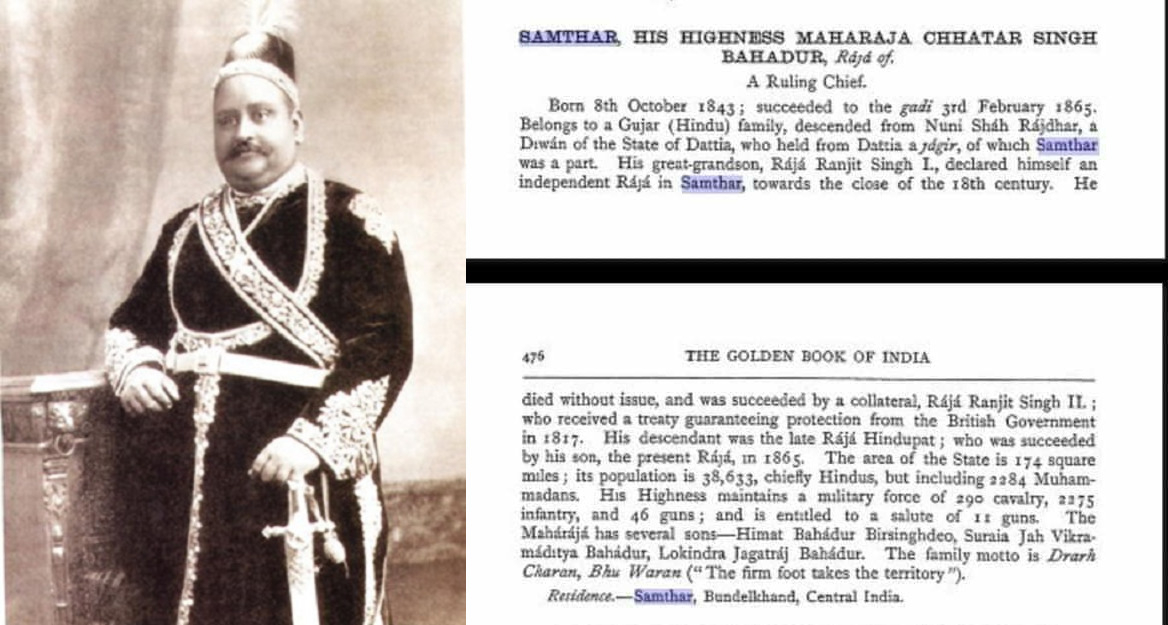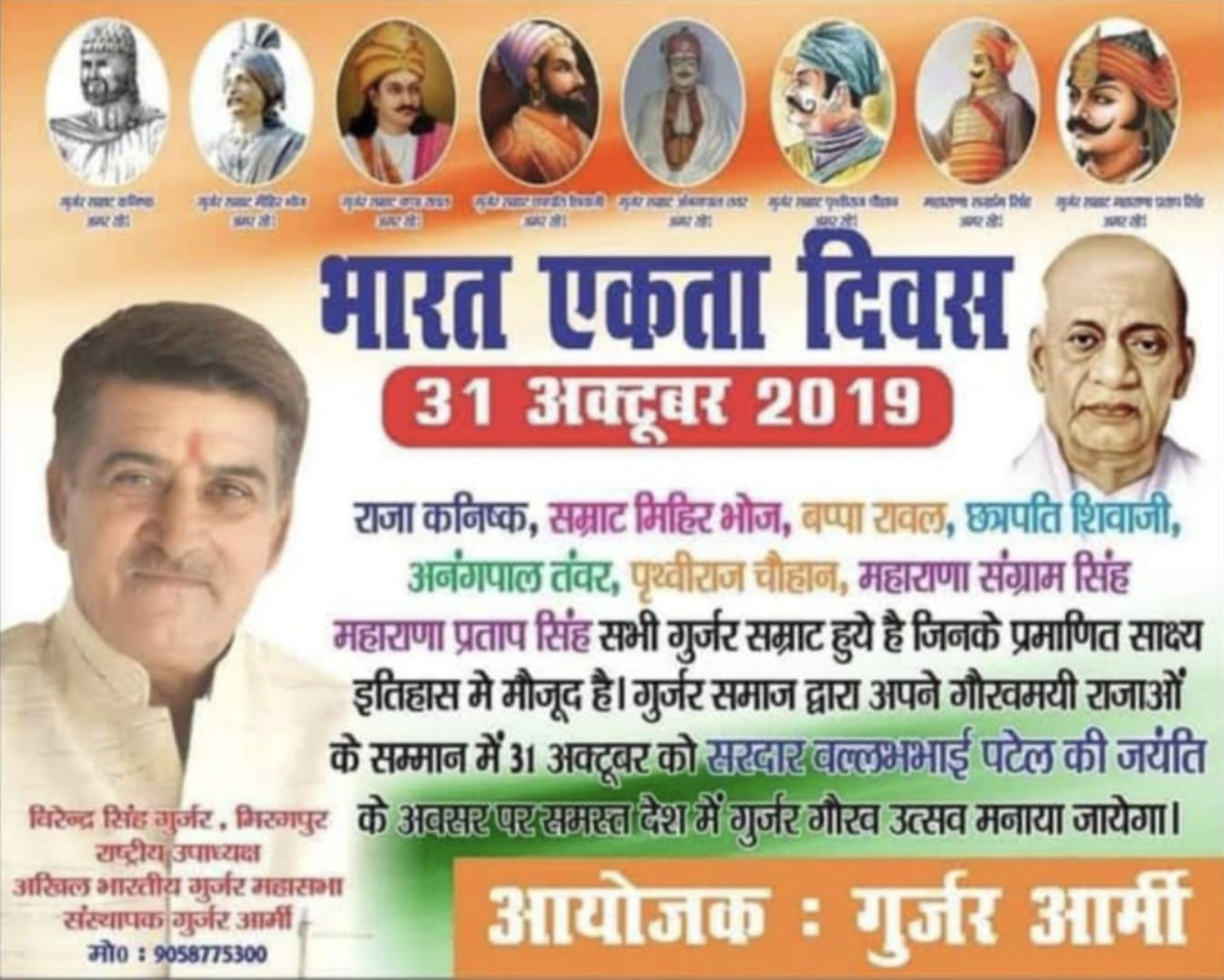Mihir Bhoja Pratihāra Controversy: The Violent Appropriation Politics of Gujjars
1. Genesis of the Mihirbhoja Controversy
 In her 2014 paper “Pastoral Predicament: The Gujjars in History ”, Prof. Shail Mayaram – made the case for the Gujjars of Rajasthan and the NCR to secure ST reservation. In the same paper, Gujjars of Rajasthan and the NCR were clubbed together, not only with the Scheduled Tribe Vangujars of Himachal, but also (quite erroneously) with the Gurjara-Pratihars (a Rajput clan). In the same vein, DailyO also published an article, dated 14-02-2019, titled “Gujjar Quota Stir: Today’s protesters are descendants of the Gurjar-Pratiharas, once among India’s grandest empires” – echoing the oft-repeated and incorrect claim connecting Gujjars to the Pratihars. In 1997, a certain part of NH-24 was renamed as “Gurjar Samrat Mihir Bhoj Marg” by the then Delhi Chief Minister Sahib Singh Verma, BJP’s Jat politician and in 2010, a statue was installed at Delhi’s Akshardham temple with inscription on the plinth which read “Gurjar Samrat Mihir Bhoj”, commemorating the Pratihar emperor.
In her 2014 paper “Pastoral Predicament: The Gujjars in History ”, Prof. Shail Mayaram – made the case for the Gujjars of Rajasthan and the NCR to secure ST reservation. In the same paper, Gujjars of Rajasthan and the NCR were clubbed together, not only with the Scheduled Tribe Vangujars of Himachal, but also (quite erroneously) with the Gurjara-Pratihars (a Rajput clan). In the same vein, DailyO also published an article, dated 14-02-2019, titled “Gujjar Quota Stir: Today’s protesters are descendants of the Gurjar-Pratiharas, once among India’s grandest empires” – echoing the oft-repeated and incorrect claim connecting Gujjars to the Pratihars. In 1997, a certain part of NH-24 was renamed as “Gurjar Samrat Mihir Bhoj Marg” by the then Delhi Chief Minister Sahib Singh Verma, BJP’s Jat politician and in 2010, a statue was installed at Delhi’s Akshardham temple with inscription on the plinth which read “Gurjar Samrat Mihir Bhoj”, commemorating the Pratihar emperor.
2. From Demanding ST Status for Benefits to Claiming Kshatriya history
 Yet, on 21-08-2012 , Gujjar organizations led by Col. Kirori Bainsla and Himmat Gujjar had actually issued a memorandum to the Rajasthan Government, stating that 99% of Gujjars are nomadic and live in forests. However, a decade later, the same Gujjar ‘leaders’ – including Mr. Himmat Gujjar – accompanied by Virendra Vikram (a shoddy member from Arya Samaj) and the Akhil Bhartiya Veer Gujar Mahasabha (ABVGM), are now militantly asserting that all pre-Mughal Rajput rulers and Rajput clans – notably the Chauhans, Pratihars, Parmars, Chandels, Bhatis, Chavdas, and Tomars – should be identified as Gujjars. A press conference was also held by the above-mentioned to this effect on October 18th, 2021. Himmat Gujjar also threatened dire consequences if the makers of Akshay Kumar-starrer film Prithviraj Chauhan don’t depict the Rajput ruler as a Gujjar. Such historical absurdities are not unique and are found in abundance on rightwing portals. Concocted tales of a Rampyari Gujjar and Jograj Gujjar (characters created out of thin-air by Manoshi Sinha in her book “Saffron Swords”) who supposedly defeated Taimur Lang find ardent support among said Gujjar leaders and organizations.
Yet, on 21-08-2012 , Gujjar organizations led by Col. Kirori Bainsla and Himmat Gujjar had actually issued a memorandum to the Rajasthan Government, stating that 99% of Gujjars are nomadic and live in forests. However, a decade later, the same Gujjar ‘leaders’ – including Mr. Himmat Gujjar – accompanied by Virendra Vikram (a shoddy member from Arya Samaj) and the Akhil Bhartiya Veer Gujar Mahasabha (ABVGM), are now militantly asserting that all pre-Mughal Rajput rulers and Rajput clans – notably the Chauhans, Pratihars, Parmars, Chandels, Bhatis, Chavdas, and Tomars – should be identified as Gujjars. A press conference was also held by the above-mentioned to this effect on October 18th, 2021. Himmat Gujjar also threatened dire consequences if the makers of Akshay Kumar-starrer film Prithviraj Chauhan don’t depict the Rajput ruler as a Gujjar. Such historical absurdities are not unique and are found in abundance on rightwing portals. Concocted tales of a Rampyari Gujjar and Jograj Gujjar (characters created out of thin-air by Manoshi Sinha in her book “Saffron Swords”) who supposedly defeated Taimur Lang find ardent support among said Gujjar leaders and organizations.

Not only do these leaders and organizations vie for ST status to collect the same socioeconomic benefits afforded to Dalit and Adivasi communities, but they also wish to be seen as descendants of Kings, Emperors and surprisingly claim to be Kshatriyas. Their claims even go beyond Rajput icons and include figures such as Shivaji Maharaj, Kanishk and all pre-Mughal era Rajput monarchs. Why Gujjar organizations are simultaneously vying for reservations whilst claiming royal descent through the appropriation of a vast array of disparate historical icons, is puzzling to say the least.
3. The recorded History of Gujjars
Their truth, however, lies somewhere in the middle of these contradictory claims. An assessment of their claims is in order. Firstly, the Gujjars of the NCR and Rajasthan were not a purely pastoral community. As such, clubbing them with the Vangujjars of the Himalayas is both unscholarly and manipulative. While their ethnonym has its roots in “gau-char”, over the centuries, they acquired lands and chaudhriyats under various Rajput kings and Mughal Emperors. Babur described them as highwaymen who poured down in huge numbers looting livestock of destitutes. Jehangir described them as a milch community that occasionally engaged in robbery (Tuzuk-i-Jehangiri, Beveridge p. 91) Later, many Gujjars were also recruited as chowkidars or watchmen in Mughal Delhi (William Dalrymple, The Last Mughal, p. 145).
 By the 18th century, a Gujjar named Nunne Shah Khatana, who served as Dewan under Datia’s Bundela Rajput ruler was granted the zamindari of Samthar by the latter. A century later, Samthar was declared an independent princely state by the British in exchange for military support (The Golden Book of India, Roper Lethbridge, p. 475-476). The Rohilla Chief Najib Khan also granted Chaudhari Manohar Singh (a Gujjar of the Khubar gotra) the zamindari of Landhaura (near Roorkee) in 1759 AD (Atkinson, 1875, p. 199-206). This zamindari swelled to include 500 villages in the British period. His descendant Raja Raghubir Khubar was granted a further 11 villages by the British regime for his ‘good’ conduct during the mutiny of 1857 (Saharanpur Gazetteer, p. 121). BJP MLA Pranav Champion belongs to this zamindar family. Likewise, late BJP MP Hukam Singh belonged to a family of Kalsan Gujjars who held a zamindari in Shamli under the Mughals. In his “The Anarchy: The East India Company, Corporate Violence, and the Pillage of an Empire” (p. 101), William Dalrymple also mentions a Gujjar Raja of 14 villages, Devi Singh, who relentlessly looted mutinying soldiers, common villagers and the British indiscriminately. Considering that many Gujjars had gradually become zamindars in the late Mughal & British era, conflating them with the Vangujars or other ST groups is just as problematic as linking them to Kshatriyas. ST and Gujjar communities do not share a common history of socio-political development. Though this does not, by any means, negate the fact that an overwhelming majority of Gujjar communities were in fact nomadic, it also does not justify categorizing certain Gujjar communities with ST communities. Gujjar organizations and leaders are playing a very insidious political game when they try to claim both ST and Kshatriya status.
By the 18th century, a Gujjar named Nunne Shah Khatana, who served as Dewan under Datia’s Bundela Rajput ruler was granted the zamindari of Samthar by the latter. A century later, Samthar was declared an independent princely state by the British in exchange for military support (The Golden Book of India, Roper Lethbridge, p. 475-476). The Rohilla Chief Najib Khan also granted Chaudhari Manohar Singh (a Gujjar of the Khubar gotra) the zamindari of Landhaura (near Roorkee) in 1759 AD (Atkinson, 1875, p. 199-206). This zamindari swelled to include 500 villages in the British period. His descendant Raja Raghubir Khubar was granted a further 11 villages by the British regime for his ‘good’ conduct during the mutiny of 1857 (Saharanpur Gazetteer, p. 121). BJP MLA Pranav Champion belongs to this zamindar family. Likewise, late BJP MP Hukam Singh belonged to a family of Kalsan Gujjars who held a zamindari in Shamli under the Mughals. In his “The Anarchy: The East India Company, Corporate Violence, and the Pillage of an Empire” (p. 101), William Dalrymple also mentions a Gujjar Raja of 14 villages, Devi Singh, who relentlessly looted mutinying soldiers, common villagers and the British indiscriminately. Considering that many Gujjars had gradually become zamindars in the late Mughal & British era, conflating them with the Vangujars or other ST groups is just as problematic as linking them to Kshatriyas. ST and Gujjar communities do not share a common history of socio-political development. Though this does not, by any means, negate the fact that an overwhelming majority of Gujjar communities were in fact nomadic, it also does not justify categorizing certain Gujjar communities with ST communities. Gujjar organizations and leaders are playing a very insidious political game when they try to claim both ST and Kshatriya status.
Secondly, District Gazetteers and other Census records show that Gujjars shared no clans with the Rajputs, except Bhati. Additionally, the Bhati Gujjars of the NCR claimed descent from the progeny of a Rajput Raja Kasan Bhati and a Gujjar woman (William Crook, Tribes & caste of North-Western Province of Agra & Oudh, vol. 2, p. 442). The same Gazetteers also reveal how Chamayan Gujjars adopted the Tomar Rajput surname, how Kalsan Gujjars of Kairana and Mavi Gujjars adopted the Chauhan Rajput surname, how Khubar Gujjars claimed to be Parmars, and how Rawal Gujjars linked themselves to Khokhar Rajputs (William Crook, Tribes & Castes of North-Western Province of Agra & Oudh, vol.2, p. 442). Similarly, Chandila Gujjars also adopted the Chandel Rajput surname. This has also been attested to by The Karnal Gazetteer and Saharanpur Gazetteer (Gazetteer Of The Karnal District 1892 – Pg 84, 111, 118). Evidently, there are no Rajput clans (i.e. Chauhans, Parmars, Pratihars/Parihars, Tomars, Solankis, Chavdas, Chandels, etc.) among Gujjars. And although the Gujjar community had adopted Rajput clan-names, the rationale given by them to colonial ethnographers for doing so remained anchored in an unsubstantiated tale of being descendants of a Rajput father and a Gujjar mother. Hence, when media houses and journalists portray the current controversy as a conflict between Gujjars & Rajputs being centered around the identity of a particular king, they are misleading and misinforming readers.
The current conflict is rooted in colonial-era Gujjar communities’ unsubstantiated claims of Rajput ancestry and is being fanned by contemporary right-wing politics of Kshatriya-ization. This Kshatriya-ization politics was started by Arya Samajis to co-opt feudal OBCs.
4. Mob-Violence Gujjar Way of Politics: Demanding Reservation or Grabbing History
 However, Gujjar leaders’ contradictory stance on reservation and history is becoming increasingly violent. In 2021 and again in 2022, Himmat Gujjar made public posts inciting various communities (Jats, Marathas, Kurmis, Dalits, Brahmins & Adivasis) to attack Rajputs, who he, ironically, accused of stealing medieval kings of other communities. Around the same time as Himmat Gujjar’s inflammatory posts, an interview of Narendra Gujjar, the president of ABVGM, also became quite viral where he used misogynistic words for Rajput women.
However, Gujjar leaders’ contradictory stance on reservation and history is becoming increasingly violent. In 2021 and again in 2022, Himmat Gujjar made public posts inciting various communities (Jats, Marathas, Kurmis, Dalits, Brahmins & Adivasis) to attack Rajputs, who he, ironically, accused of stealing medieval kings of other communities. Around the same time as Himmat Gujjar’s inflammatory posts, an interview of Narendra Gujjar, the president of ABVGM, also became quite viral where he used misogynistic words for Rajput women.
September 2021 witnessed large-scale violence by Gujjars in three districts of Madhya Pradesh (Gwalior, Bhind & Morena) over the issue of the medieval Rajput king – mostly vandalizing public transport. On July 20, 2023, the BJP MLA of Kaithal, Leela Ram Gujjar, spearheaded the inauguration of a statue addressing Mihirbhoj Pratihar as Gujjar which was followed by lathicharge on protesting Parihar Rajputs. On 25 September 2023, a gathering of 700 Gujjars under the leadership of Atul Pradhan again rioted in Gwalior just to appropriate the history of Chauhan and Pratihara Rajputs – this time beating local civilians and attacking police.
Clearly, casteist politics backed by fringe academic theories and unethical politics have mixed to create a new mob-style politics of propaganda, intimidation and collective violence. As Gujjar organizations and their shifting narratives are challenged, their organizations and leaders are becoming increasingly violent. Their bully behavior is oddly being defended both in the name of Hindutva unity and the Subaltern Bahujan politics.

